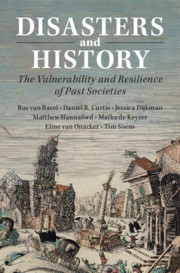This book has emerged in the context of four key developments occurring over the past decade or so in the broad field of ‘the history of disasters.’ These are, first, the growing recognition that natural conditions and events likely had an important role to play in determining historical outcomes; second, the increasing use of non-documentary sources – including DNA, tree rings, and ice-cores – and the related quest for linking the natural and social sciences; third, the establishment of very large digital databases of information; and fourth, the gradual dominance of an explanatory framework for disasters that emphasizes resilience, and, more specifically, adaptation. One of the goals of this book is to trace these developments and how they have recently shaped our understanding of the interaction between disasters and history. More significantly, however, we also offer some critique. Indeed, as a team of historians co-writing with an emphasis on social history, we suggest through the course of the book that although interaction with geneticists, climatologists, statisticians, and so on has brought many new advantages to our study of disasters in the past, we also need to continue to pay heed to ‘traditional’ historical skills – in particular the assessment of new data with regard to source critique and contextualization of evidence. Perhaps even more explicitly, however, given the emphasis on social history, we also put forward a view that we should not forget the significance of social relations and of disparities in advantages, opportunities, and access to resources between social groups. Indeed, history shows that while economic, institutional, agricultural, and ecological systems often remained resilient in the face of significant hazards – many of which led to disaster – significant social groups within those very same systems were often vulnerable, and suffered many hardships. We should be careful not to push these dimensions out of view.
The authors offer thanks to the editor, Michael Watson, and the staff of Cambridge University Press, and the three anonymous referees for their suggestions and comments on the first proposal for this volume. Similarly, we thank Bin Wong (UCLA) and Eleonora Rohland (Bielefeld) for their comments on the first draft, and Heli Huhtamaa (Bern/Heidelberg), Joris Roosen (Utrecht) and Franz Mauelshagen (IASS Potsdam/Essen) for their comments and the extensive discussion we had at a workshop in Utrecht. Bram Hilkens (Erasmus University Rotterdam) and Constant van der Putten (Utrecht University) helped greatly with the technical editing, while Constant also took care of the illustrations, and Eileen Power helped us by checking the language. We are grateful to all of the people involved in this collective effort.

